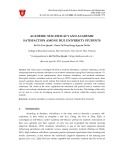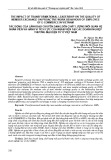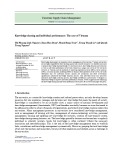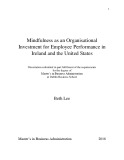
TNU Journal of Science and Technology
230(03): 3 - 10
http://jst.tnu.edu.vn 3 Email: jst@tnu.edu.vn
EXAMINATION OF INTRINSIC, EXTRINSIC MOTIVATION AND
SELF-EFFICACY ON FOSTERING INNOVATIVE WORK BEHAVIOR
– A CASE STUDY OF ZAMIL STEEL IN VIETNAM
Duong Thi Hoai Nhung1*, Heba Mostafa Saud Mahroos2
1Foreign Trade University
2Ministry of Health, Saudi Arabia
ARTICLE INFO
ABSTRACT
Received:
06/8/2024
The study aims to determine the effect of intrinsic, extrinsic motivation
and self-efficacy on innovative work behavior. The relationships are
investigated in the light of self-determination theory. The research
method combined qualitative and quantitative methods. In the
beginning, data was collected by interviewing experts and managers of
Zamil steel company, Vietnam. Then, the research conducted a
structured questionnaire survey for employees at the company. The
sample was collected from 344 respondents via Google forms. The data
was analyzed by SPSS software and regression analysis for hypothesis
testing. The findings indicated that there are positive effects of extrinsic
motivation and self-efficacy on innovative work behavior, in which
self-efficacy has stronger positive impacts than extrinsic motivation on
innovative work behavior. There is no relationship between intrinsic
motivation and innovative work behavior. This study also suggests
some implications for researchers and managers to implement findings
and insights to foster innovative work behavior.
Revised:
05/11/2024
Published:
11/02/2025
KEYWORDS
Intrinsic motivation
Extrinsic motivation
Self-efficacy
Innovative work behavior
Self-determination theory
KIỂM CHỨNG SỰ TÁC ĐỘNG CỦA NỘI ĐỘNG LỰC, NGOẠI ĐỘNG LỰC,
SỰ TỰ TIN VÀO NĂNG LỰC BẢN THÂN TỚI HÀNH VI LÀM VIỆC ĐỔI MỚI
- NGHIÊN CỨU ĐIỂN HÌNH TẠI CÔNG TY THÉP ZAMIL, VIỆT NAM
Dương Thị Hoài Nhung1*, Heba Mostafa Saud Mahroos2
1Trường Đại học Ngoại thương
2Bộ Y tế, Ả-Rập-Xê-Út
THÔNG TIN BÀI BÁO
TÓM TẮT
Ngày nhận bài:
06/8/2024
Nghiên cứu nhằm mục đích xác định ảnh hưởng của nội động lực, ngoại
động lực và sự tự tin vào năng lực bản thân đến hành vi làm việc đổi
mới. Các mối quan hệ được xem xét dựa trên lý thuyết nền tảng về sự tự
quyết. Phương pháp nghiên cứu kết hợp phương pháp định tính và định
lượng. Ban đầu, dữ liệu được thu thập bằng cách phỏng vấn các chuyên
gia và quản lý tại công ty thép Zamil, Việt Nam. Sau đó, nghiên cứu đã
tiến hành khảo sát bằng bảng câu hỏi có cấu trúc dành cho nhân viên làm
việc tại công ty. Mẫu được thu thập từ 344 người trả lời thông qua biểu
mẫu của Google. Dữ liệu được phân tích bằng phần mềm SPSS và phân
tích hồi quy để kiểm định giả thuyết. Các phát hiện chỉ ra rằng có sự tác
động tích cực giữa ngoại động lực và sự tự tin vào năng lực bản thân đối
với hành vi làm việc đổi mới, trong đó sự tự tin vào năng lực bản thân có
tác động tích cực mạnh mẽ hơn ngoại động lực đến hành vi làm việc đổi
mới. Không có mối quan hệ giữa nội động lực và hành vi làm việc đổi
mới. Nghiên cứu này cũng gợi ý một số hàm ý cho các nhà nghiên cứu,
và nhà quản lý trong việc triển khai các phát hiện và hiểu biết nhằm thúc
đẩy hành vi làm việc đổi mới.
Ngày hoàn thiện:
05/11/2024
Ngày đăng:
11/02/2025
TỪ KHÓA
Nội động lực
Ngoại động lực
Sự tự tin vào năng lực bản thân
Hành vi làm việc đổi mới
Lý thuyết về sự tự quyết
DOI: https://doi.org/10.34238/tnu-jst.10881
* Corresponding author. Email: nhungdth@ftu.edu.vn






















